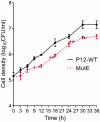Anti- Helicobacter pylori activity of ethoxzolamide
- PMID: 31530039
- PMCID: PMC6759998
- DOI: 10.1080/14756366.2019.1663416
Anti- Helicobacter pylori activity of ethoxzolamide
Abstract
Ethoxzolamide (EZA), acetazolamide, and methazolamide are clinically used sulphonamide drugs designed to treat non-bacteria-related illnesses (e.g. glaucoma), but they also show antimicrobial activity against the gastric pathogen Helicobacter pylori. EZA showed the highest activity, and was effective against clinical isolates resistant to metronidazole, clarithromycin, and/or amoxicillin, suggesting that EZA kills H. pylori via mechanisms different from that of these antibiotics. The frequency of single-step spontaneous resistance acquisition by H. pylori was less than 5 × 10-9, showing that resistance to EZA does not develop easily. Resistance was associated with mutations in three genes, including the one that encodes undecaprenyl pyrophosphate synthase, a known target of sulphonamides. The data indicate that EZA impacts multiple targets in killing H. pylori. Our findings suggest that developing the approved anti-glaucoma drug EZA into a more effective anti-H. pylori agent may offer a faster and cost-effective route towards new antimicrobials with a novel mechanism of action.
Keywords: MIC/MBC; Mutation frequency; ethoxzolamide; genome sequencing.
Figures





References
-
- Hooi JKY, Lai WY, Ng WK, et al. . Global prevalence of Helicobacter pylori infection: systematic review and meta-analysis. Gastroenterology 2017;153:420–9. - PubMed
-
- Take S, Mizuno M, Ishiki K, et al. . Seventeen-year effects of eradicating Helicobacter pylori on the prevention of gastric cancer in patients with peptic ulcer; a prospective cohort study. J Gastroenterol 2015;50:638–44. - PubMed
-
- Uemura N, Okamoto S, Yamamoto S, et al. . Helicobacter pylori infection and the development of gastric cancer. N Engl J Med 2001;345:784–9. - PubMed
MeSH terms
Substances
LinkOut - more resources
Full Text Sources
Other Literature Sources
Medical
